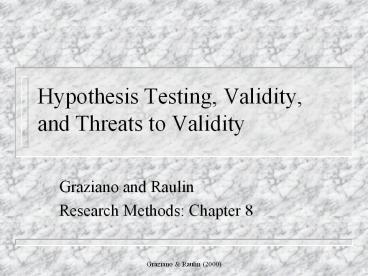Hypothesis Testing, Validity, and Threats to Validity - PowerPoint PPT Presentation
Title:
Hypothesis Testing, Validity, and Threats to Validity
Description:
Hypothesis Testing, Validity, and Threats to Validity Graziano and Raulin Research Methods: Chapter 8 Testing Hypotheses Scientific research tests specific hypotheses ... – PowerPoint PPT presentation
Number of Views:407
Avg rating:3.0/5.0
Title: Hypothesis Testing, Validity, and Threats to Validity
1
Hypothesis Testing, Validity,and Threats to
Validity
- Graziano and Raulin
- Research Methods Chapter 8
2
Testing Hypotheses
- Scientific research tests specific hypotheses
- Generated from the initial research idea through
a series of steps (Figure 8.1) - A given research idea can easily generate dozens
of research hypotheses - Depending on how it is translated into a
statement of the problem and how the variables in
the statement of the problem are operationally
defined
3
The Initial Idea
- The initial idea is the starting point
- Often vague or general, it requires refining
before research hypotheses can be generated - Refinement of the initial idea is based on
- (1) a search of relevant research literature
- (2) initial observations of the phenomenon
- Want to narrow and formalize the initial idea
into a statement of the problem
4
Statement of the Problem
- In the form of a question that clearly indicates
an expected relationship - The nature of the question will dictate the
required level of constraint of a study - Causal questions will require experimental
research - Questions about relationships can be answered
with lower constraint research - Convert into research hypotheses by operationally
defining the variables
5
Generating Research Hypotheses
- Ideas lead to
- observations
- library research
- Statement of problem
- Problem statements become research hypotheses
when constructs are operationalized
6
Operational Definitions
- Initially covered in Chapter 3
- The procedures used to measure and/or manipulate
a variable - Most variables can be operationally defined in
many different ways, thus creating many different
research hypotheses from a single statement of
the problem
7
Research Hypotheses
- States clearly the expected relationship between
the variables - The form is a declarative statement, but it is a
tentative statement to be tested in research - Implicitly or explicitly, the variables in the
research hypothesis are stated in operational
definition terms
8
The Role of Theory
- In all research planning, theory guides the
process - Theory is often the primary source of the
research hypothesis - Theory guides the selection of variables as well
as their operational definitions - Most research is based on multiple, overlapping
and interacting theories
9
Testing Research Hypotheses
- Actually testing three hypotheses
- The null hypothesis
- The confounding variable hypothesis
- The causal hypothesis
- Accept causal hypothesis only if you
- reject null hypothesis (statistical analysis)
- rule out each potential confounding variable
hypothesis (based on appropriate controls)
10
Types of Validity
- Statistical Validity
- Are the statistical tests accurate?
- Construct Validity
- Is our theory the best explanation for the
results? - External Validity
- Do the results apply to the broader population?
- Internal Validity
- Is the independent variable responsible for the
observed changes in the dependent variable?
11
Avoiding Confounding
- Confounding and internal validity
- Many sources for confounding (covered next)
- With proper controls (see Chapter 9), confounding
can be virtually eliminated - Confounding and construct validity
- Make sure that you have considered alternative
theoretical explanations for the anticipated
phenomenon
12
Confounding Variables (1/3)
- Maturation
- Changes due to normal growth or predictable
changes - History
- Changes due to an event that occurs during the
study, which might have affects the results - Testing
- Changes due to the effects of previous testing
13
Confounding Variables (2/3)
- Instrumentation
- Any change in the calibration of the measuring
instrument over the course of the study - Regression to the Mean
- Tendency for participants selected because of
extreme scores to be less extreme on a retest - Selection
- Any factor that creates groups that are not equal
at the start of the study
14
Confounding Variables (3/3)
- Attrition
- Loss of participants during a study are the
participants who drop out different from those
who continue? - Diffusion of treatment
- Changes in participants behavior in one
condition because of information they obtained
about the procedures in other conditions - Sequence Effects
- Effects on performance in one condition due to
experience with previous conditions
15
Subject Effects
- Participants are not passive
- They try to understand the study to help them to
know what they should do - This behavior termed subject effects
- Participants respond to subtle cues about what is
expected (termed demand characteristics) - Placebo effect treatment effect that is due to
expectations that the treatment will work
16
Experimenter Effects
- Any preconceived idea of the researcher about how
the experiment should turn out - Affect the outcome of studies if not properly
controlled - May be due to the experimenter providing demand
characteristics to the participant - Not the same as scientific fraud (which is
deliberate)
17
Validity, Control, Constraint
- Three closely-tied concepts
- Validity
- Refers to the scientific accuracy of the study or
procedure - It is increased by using appropriate control
procedures - The more controls we employ in a study, the
higher the level of constraint
18
Summary
- Start by building a research hypothesis
- Testing the research hypothesis is actually
testing three hypotheses - (1) null (2) confounding-variable (3) causal
- Several types of validity
- Many potential confounding variables
- Subject and experimenter effects can also affect
the outcome of the study































